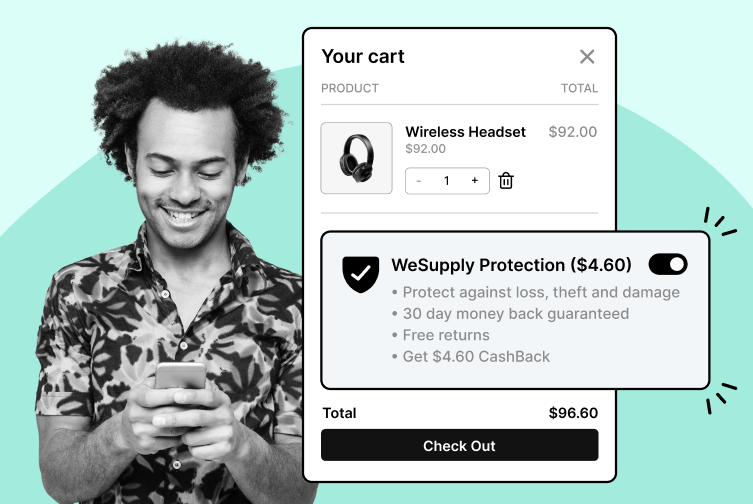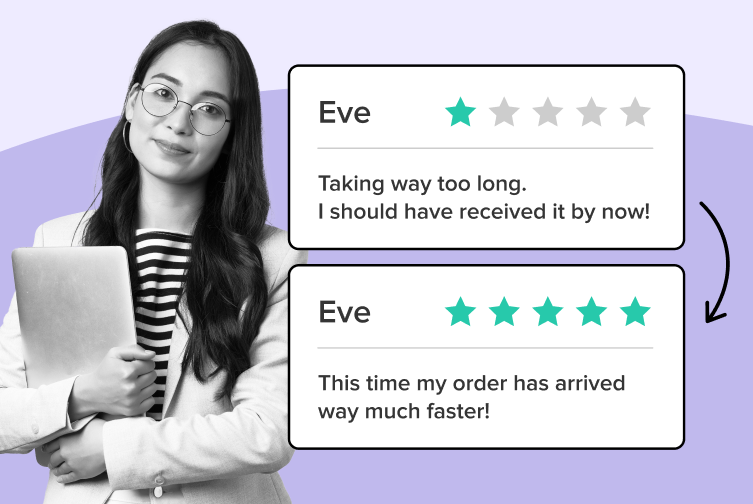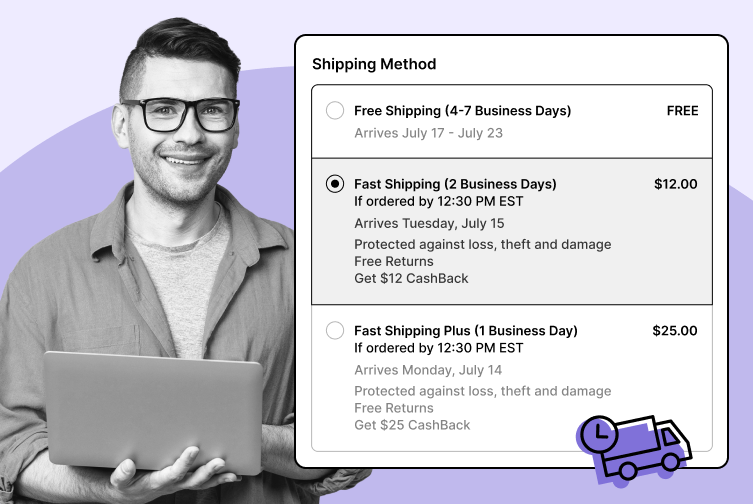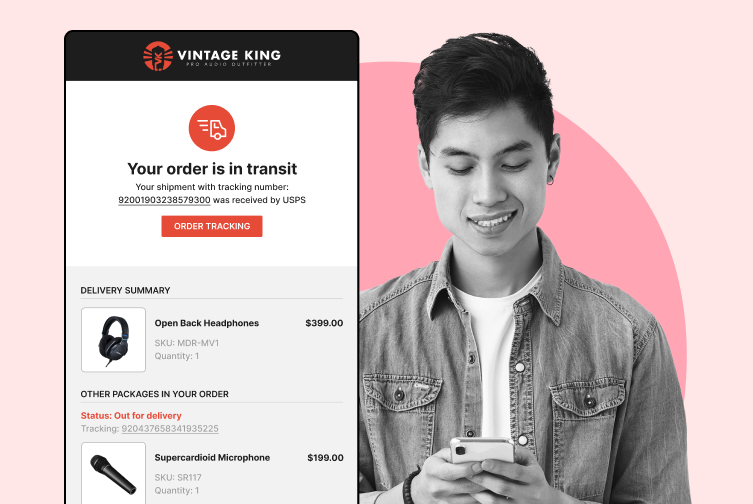
How to Leverage AI Powered Ecommerce Shipping Solutions
Discover how AI-powered eCommerce shipping solutions can streamline operations and boost customer satisfaction!
Shipping, Tracking & Notifications
Boost customer experience and reduce support tickets
Realtime order and shipment tracking
Proactive order and shipping notifications
AI-Enhanced Discounted Labels
Predictive pre-purchase estimated delivery dates
Self-Serivce branded order tracking
Effortless experience delivered
Identify and Resolve Order Issues
Realtime order and shipment tracking
Make returns profitable and delight customers
Flexibility to define any return destinations & conditions
Simplify returns for your customers and team
Incentivize exchanges over returns
Returns management made easy for your team
Returns management made easy for your team
Easy claims and smart upsells
Understand why your customers are returning
In-Store & Curbside Pickup
Unify the online and the in-store experience
Hassle-free pickup experience for customers
In-Store dashboard to keep operations streamlined
In-Store and Online orders unified
Drive foot-traffic to your stores
Shipping, Tracking & Notifications
Boost customer experience and reduce support tickets
Realtime order and shipment tracking
Proactive order and shipping notifications
AI-Enhanced Discounted Labels
Predictive pre-purchase estimated delivery dates
Self-Serivce branded order tracking
Effortless experience delivered
Identify and Resolve Order Issues
Realtime order and shipment tracking
Make returns profitable and delight customers
Flexibility to define any return destinations & conditions
Simplify returns for your customers and team
Incentivize exchanges over returns
Returns management made easy for your team
Returns management made easy for your team
Understand why your customers are returning
In-Store & Curbside Pickup
Unify the online and the in-store experience
Hassle-free pickup experience for customers
In-Store Dashboard to keep operations streamlined
In-Store and Online orders unified
Drive foot-traffic to your stores
Boost customer experience and reduce support tickets
Realtime order and shipment tracking
Proactive order and shipping notifications
AI-Enhanced Discounted Labels
Predictive pre-purchase estimated delivery dates
Self-Serivce branded order tracking
Effortless experience delivered
Make returns profitable and delight customers
Flexibility to define any return destinations & conditions
Simplify returns for your customers and team
Incentivize exchanges over returns
Returns management made easy for your team
Equip your team for precise return checks.
Easy claims and smart upsells
Understand why your customers are returning
Unify the online and the in-store experience
Hassle-free pickup experience for customers
In-Store Dashboard to keep operations streamlined
In-Store and Online orders unified
Drive foot-traffic to your stores
Find the answer to all your questions
Take a step by step trip through our functionality to see how we can improve your ecommerce processes.
Explore the most comon questions about WeSupply
Calculate the ROI that WeSupply can bring you
Read actionable articles on how to optimize your post-purchase experience and decrease support tickets
Get inspired by stories of how our customers implemented an effortless post-purchase experience
Wondering if WeSupply is a good fit for you? Read through our use cases to see how we can help you increase conversion & improve CX!
A Deep Dive into Top Companies' Order Tracking & Returns Strategy
Find the answer to all your questions
Explore the most comon questions about WeSupply
Calculate the ROI that WeSupply can bring you
Request a no strings attached review of your current shopping experience and missed conversion opportunities
Take a step by step trip through our functionality to see how we can improve your ecommerce processes.
Read actionable articles on how to optimize your post-purchase experience and decrease support tickets
Get inspired by stories of how our customers implemented an effortless post-purchase experience
A Deep Dive into Top Companies' Order Tracking & Returns Strategy
Wondering if WeSupply is a good fit for you? Read through our use cases to see how we can help you increase conversion & improve CX!

In today’s ecommerce landscape, sustainability is no longer just a buzzword—it’s a business imperative. As global concern for the environment intensifies, online shoppers are becoming increasingly conscious of their carbon footprint. With the rapid growth of online shopping, especially during the pandemic, there is greater scrutiny on the environmental impact of ecommerce and heightened expectations for sustainable practices. They want to know: Was this item packaged responsibly? How far did it travel? Can I recycle this box? And above all, they expect brands to lead the charge in offering eco-friendly alternatives.
At the same time, ecommerce companies are under immense pressure to maintain healthy margins while balancing sustainability and profitability. Between rising fuel prices, complex logistics, and fierce competition, it can feel like going green is just another expense. But here’s the good news: sustainable shipping doesn’t have to drain your profits. In fact, when executed strategically, it can become a powerful driver of efficiency, loyalty, and long-term cost savings.
This guide will show you how to build a sustainable shipping strategy that doesn’t just check the environmental boxes, but actively supports your bottom line. Let’s dive into the what, why, and how of profitable, planet-friendly ecommerce logistics.
The demand for sustainable shipping isn’t a passing trend. A growing number of consumers especially Millennials and Gen Z are factoring sustainability into their purchasing decisions. Studies show that nearly 60% of shoppers are willing to pay more for products delivered through eco-friendly methods. What was once a niche concern has become a key competitive differentiator, as growing environmental concerns are driving demand for sustainable shipping solutions.
Beyond customer expectations, environmental regulations are also tightening. Governments around the world are introducing carbon taxes, emissions limits, and packaging waste restrictions that directly affect ecommerce operations. Businesses that proactively align with these changes will be better positioned to adapt and grow.
There’s also a reputational factor. Brands that invest in sustainable shipping can market themselves as environmentally responsible and forward-thinking. This resonates with values-driven consumers, drives loyalty, and boosts brand equity. In contrast, those seen as wasteful or indifferent may lose trust and market share.
In short, eco-friendly shipping isn’t just good for the planet it’s critical for long-term profitability.
To build a more sustainable shipping model, it helps to understand what contributes to the environmental impact of ecommerce logistics. First, there’s the transportation itself. The emissions from trucks, planes, and last-mile delivery vans add up quickly, especially when packages are shipped individually across long distances. These transportation emissions, along with other logistics activities, increase the overall ecological footprint of the shipping process.
Then there’s packaging waste. Overboxing, plastic fillers, and non-recyclable materials clog landfills and increase dimensional (DIM) weight, which raises both environmental and shipping costs. Many retailers still default to large boxes for small items, leading to unnecessary waste and higher emissions per shipment.
Reverse logistics or the process of handling returns is another hidden footprint. When products are returned, they often travel just as far (if not further) than the initial delivery. Returned items may need to be repackaged, inspected, or even discarded, adding to waste and operational costs.
Understanding these elements gives you a clearer roadmap: optimize the shipping process to reduce ecological footprint and costs by reducing transportation emissions, improving packaging, and managing returns more sustainably.
Eco-friendly shipping doesn’t have to come with a hefty price tag. Today, there are a variety of cost-effective shipping solutions that help ecommerce businesses minimize their environmental footprint while meeting customer expectations for sustainability. One of the most impactful changes is switching to biodegradable packaging materials, such as compostable mailers and recyclable shipping boxes. These eco friendly packaging options not only reduce solid waste but also signal to environmentally conscious consumers that your brand is committed to minimizing environmental impact.
Another smart move is to prioritize ground-based shipping over expedited air shipping whenever possible. Ground shipping typically generates far fewer carbon emissions, making it a more sustainable choice that also tends to be more cost effective. By offering friendly shipping options that balance speed with sustainability, you can reduce your environmental footprint and appeal to customers who value eco friendly shipping practices.
Implementing these eco friendly shipping solutions helps businesses achieve their sustainability goals without sacrificing profitability. Not only do these practices minimize environmental impact, but they also foster brand loyalty among shoppers who are increasingly seeking out brands that share their values. By making small, strategic changes like using biodegradable packaging materials and optimizing shipping methods you can deliver on both your environmental and business objectives.
One of the easiest and most impactful places to start is with packaging. Sustainable packaging doesn’t have to be expensive in fact, it often saves money when done correctly.
Switching to recycled or compostable materials is one option. Using biodegradable materials, compostable packaging, and sustainable materials are excellent eco friendly options that help reduce environmental impact. Kraft paper, corrugated cardboard, recycled paper, and biodegradable mailers are now widely available at competitive prices. Many suppliers offer bulk discounts, and switching to lighter materials can reduce shipping costs by lowering DIM weight.
Another major cost saver is right-sizing your packaging. By using smaller boxes or poly mailers that better fit your products, you reduce waste and avoid paying for empty space. Choosing eco friendly boxes, eco friendly shipping boxes, recyclable packaging, and sustainable packaging materials further minimizes your environmental footprint. Dimensional weight pricing penalizes inefficient packaging, so optimizing your box sizes can directly reduce carrier fees.
Some brands have invested in packaging automation, which uses software and machinery to determine the ideal box size and packing method for each order. This cuts material usage and packing labor while improving shipping efficiency. Incorporating other packaging materials such as biodegradable packing peanuts, compostable tape, and alternatives to plastic bags and bubble wrap can further enhance your eco friendly practices.
Adopting eco friendly packaging solutions and sustainable packaging solutions in your ecommerce packaging is essential for reducing environmental impact and supporting your brand values. Implementing these packaging solutions demonstrates a commitment to eco friendly practices, meets customer expectations, and helps position your business as a leader in sustainability.
Beyond packaging, your shipping strategy can play a huge role in sustainability and profitability. One of the most effective tactics is logistics optimization. Green logistics, which focuses on implementing sustainable practices in transportation, packaging, and energy use, is now a key part of reducing environmental impact in modern supply chain management.
Start with route optimization. Advanced logistics software can map out the most fuel-efficient delivery routes, reducing fuel use, delivery time, and emissions. This not only shrinks your carbon footprint but also lowers costs by streamlining operations.
Regional warehousing is another powerful approach. By distributing inventory across multiple fulfillment centers closer to your customer base, you can dramatically cut the distance packages travel. Shorter delivery distances mean faster shipping, lower emissions, and reduced fuel and labor costs.
If running your own network is too complex, consider partnering with third-party logistics (3PL) providers that already have green initiatives in place. Some 3PLs use electric or hybrid delivery vehicles, operate carbon-neutral facilities, utilize renewable energy sources to power their operations, or offer consolidated shipping options.
Automation also plays a role. AI-driven warehouse management systems can reduce human error, increase picking and packing efficiency, and minimize waste throughout the order lifecycle.
In essence, optimizing your logistics is a win-win: it helps the planet while improving your operational efficiency and scalability.
Carbon offset shipping is a powerful way for ecommerce businesses to take responsibility for their carbon footprint and make every delivery more sustainable. This approach involves calculating the carbon emissions generated by each shipment and then investing in projects that remove or reduce an equivalent amount of greenhouse gas emissions such as reforestation, renewable energy, or clean energy initiatives.
By integrating carbon offset shipping into your fulfillment process, you can effectively neutralize the carbon emissions associated with your deliveries. This not only helps reduce your overall environmental impact but also demonstrates a strong commitment to environmental stewardship and eco friendliness. For many businesses, carbon offsetting is a cost effective solution, as it allows you to address your carbon footprint without the need for major investments in new infrastructure or technology.
Adopting carbon offset shipping is also a great way to connect with customers who prioritize reducing carbon emissions and supporting brands that invest in a sustainable future. By making your carbon offset efforts visible through checkout options, product pages, or sustainability reports you can build trust and loyalty with eco-minded shoppers while contributing to broader sustainability goals.
Returns are often overlooked in the sustainability conversation, but they carry a significant environmental and financial cost. Every returned product doubles the shipping emissions and often results in repackaging, refurbishment, or even disposal.
Reducing return rates should be a core part of your eco-shipping strategy. One way to do this is by helping customers make more informed purchases. Detailed product descriptions, size guides, high-quality images, and customer reviews all reduce the likelihood of returns.
Augmented reality (AR) and virtual try-on tools can further improve purchase accuracy, especially in categories like apparel, furniture, or cosmetics. These tools reduce the guesswork and boost customer confidence.
User-generated content (UGC), such as customer photos and videos, also help set accurate expectations. When shoppers see how a product looks in real life, they’re less likely to be disappointed or surprised.
Finally, consider making your return process itself more sustainable. Offer box-free drop-off locations, consolidate return shipments, or incentivize customers to keep items through partial refunds or exchanges. You can also encourage customers to adopt more sustainable practices, such as reusing packaging for returns or consolidating multiple items into a single shipment. Solutions like WeSupply allow retailers to automate return routing and track the carbon impact of each return, enabling smarter, greener decisions.
Reducing returns is a direct path to lower emissions and higher profit margins.
Partnering with third-party logistics (3PL) providers can be a game-changer for ecommerce businesses aiming to implement sustainable shipping practices. Many 3PLs now specialize in eco friendly shipping and offer a suite of sustainable solutions, from biodegradable packaging and compostable mailers to recyclable shipping boxes and other eco friendly packaging materials. By tapping into their expertise, you can access the most eco friendly packaging options and streamline your supply chain for a lower environmental footprint.
3PL providers can also help optimize delivery routes, reducing fuel consumption and carbon emissions across your logistics operations. Their advanced technology and network of fulfillment centers make it easier to implement sustainable shipping practices, such as consolidating shipments and using ground-based transportation to further minimize environmental impact.
Additionally, many 3PLs offer guidance on carbon offsetting, helping you effectively implement programs that reduce your carbon emissions and support your sustainability goals. By leveraging third party logistics, you can scale your sustainability efforts, achieve a more sustainable future, and meet the growing expectations of environmentally conscious consumers all while maintaining operational efficiency and cost effectiveness.
Your customers want to do their part so let them. Giving shoppers the choice to support sustainable shipping options can increase satisfaction while keeping costs in check.
One popular tactic is offering carbon-neutral shipping as a checkout option. You can calculate and offset emissions through platforms like EcoCart or Cloverly, often for just a few cents per order. Present it as an optional add-on or, better yet, bake it into your shipping promise as a brand value.
Another approach is offering “green” shipping speeds. Instead of defaulting to the fastest possible delivery, give customers the option to choose slower, more sustainable shipping in exchange for loyalty points or discounts. Many customers are willing to wait a bit longer if it means reducing their carbon footprint.
You can also educate and engage customers through your packaging, product pages, and post-purchase emails. Highlight the eco-friendly materials you use, your carbon reduction efforts, and your commitment to sustainability practices, such as adopting environmentally conscious shipping methods and responsible packaging. Sharing these sustainability practices helps build trust and demonstrates your dedication to reducing environmental impact.
Transparency builds trust and encourages repeat purchases from values-aligned customers. When people feel like they’re part of a larger mission, they’re more likely to stay loyal.
Sustainability is not a one-and-done project. To ensure lasting impact (and profit), you need to track your progress and communicate it effectively.
Start by measuring your baseline emissions and waste. Use tools that integrate with your ecommerce platform to estimate the carbon output of shipping and returns. From there, track improvements over time as you optimize routes, packaging, and returns.
Publish your progress through sustainability reports or landing pages that customers can view. Highlight metrics like “X lbs of packaging saved,” “X% reduction in emissions,” or “X% of orders shipped with carbon offsets.”
Platforms like WeSupply allow ecommerce teams to automate return tracking, monitor shipping patterns, and gather data that supports sustainability KPIs. You can also integrate this data with platforms like Shopify or Klaviyo to personalize messaging and drive loyalty campaigns based on eco-conscious behavior.
Showing your work doesn’t just help with compliance and investor relations—it inspires customers and reinforces brand loyalty.
Sustainable shipping has its challenges, but they’re not insurmountable. The key is tackling them with practical, cost-effective solutions.
Worried about packaging costs? Start with hybrid packaging a mix of recycled and virgin materials and negotiate rates with eco-packaging suppliers. You can also test alternative materials on your most popular SKUs before scaling.
Think customers won’t accept slower shipping? Reframe it as a premium, eco-conscious option and reward customers who choose it. Transparency and education go a long way.
Feeling overwhelmed by logistics complexity? Lean on automation tools and 3PLs with proven green practices. You don’t need to build everything in-house to benefit from sustainable infrastructure.
Concerned about upfront investments? Remember that many sustainable changes actually reduce operational costs in the long run through fewer returns, lower shipping fees, and stronger customer loyalty.
Sustainability doesn’t have to come at the expense of growth. With the right mindset and partners, it can fuel it.
Eco-conscious shipping doesn’t have to eat into your margins. WeSupply gives ecommerce brands the tools to build a profitable and sustainable shipping strategy from checkout to returns without compromising customer experience. Whether you’re cutting emissions, reducing packaging waste, or simplifying reverse logistics, WeSupply makes it easier to go green and grow.
Here’s how WeSupply helps you bridge the gap between sustainability and profitability:
Self-Service Return Center lets customers initiate returns online without staff involvement reducing delays and support load.
Printerless Returns via QR Codes support USPS and FedEx, letting shoppers drop off packages at over 200,000 locations without needing to print anything.
Return Label Automation allows customers to generate return labels 24/7 using the lowest-cost carrier—no email threads, no staff bottlenecks.
Digital Receipts replace paper with a fully branded digital experience that boosts transparency and reduces waste.
Streamlined exchanges and intelligent return approvals reduce repackaging, restocking, and landfill-bound items.
Enable ship-to-store and pickup options to reduce residential delivery miles and carbon output.
Optimize fulfillment with store-based pickups, curbside delivery, and regional fulfillment logic.
Provide real-time updates to cut WISMO inquiries and prevent re-shipments due to missed deliveries.
Buy Online, Pickup In Store (BOPIS): Drive foot traffic and reduce shipping costs by letting customers retrieve orders locally.
Curbside Pickup: Offer a seamless, contactless option with check-in, vehicle detection, and real-time staff alerts reducing idle time and fuel usage.
Buy Online, Ship to Store: Consolidate shipments and reduce last-mile emissions while encouraging in-store discovery.
Buy Online, Return In Store: Boost conversion and loyalty by offering frictionless, pre-approved in-store returns turning returns into upsell opportunities.
Buy In Store, Return Online: Centralize and automate the returns process across all channels for maximum flexibility and customer satisfaction.
Branded Order Tracking Pages provide clear visibility and reduce the need for redundant communications.
Pickup & Return Notifications via SMS and email ensure customers take timely action minimizing idle returns and excessive back-and-forth.
Keep your customers informed at every step when an order is en route, when it’s ready for pickup, and when a return is processed.
Monitor return rates, shipping patterns, and sustainability KPIs to identify high-impact changes.
Use data to personalize marketing, highlight carbon savings, and boost loyalty with eco-conscious segments.
Integrate seamlessly with platforms like Shopify, Klaviyo, and more for unified sustainability messaging and automation.
WeSupply gives you all the tools to offer greener, smarter ecommerce shipping without losing profit. Automate returns, cut waste, consolidate deliveries, and empower your customers to make sustainable choices all while reducing operational costs and boosting lifetime value.
Start reducing your environmental footprint and your costs start your 14-day free trial today and show your customers that green and growth can go hand in hand.
The notion that sustainability and profitability can’t coexist is no longer true. Ecommerce brands today are proving you can reduce environmental impact and still grow your margins especially with platforms like WeSupply making it easier than ever.
By automating return label generation, offering printerless QR code drop-offs, and providing eco-conscious options like ship-to-store, curbside pickup, and in-store returns, WeSupply helps you cut waste and lower costs while enhancing customer experience. Its tools for return routing, carbon impact tracking, and branded digital receipts help you reduce emissions without adding complexity. With real-time notifications and integrations with Shopify and Klaviyo, you can keep customers informed and engaged throughout the order journey.
Sustainable shipping isn’t just good for the planet it’s a smarter, more efficient way to run your business. Start small, track your progress, and let tools like WeSupply turn your green initiatives into growth drivers.
Eliminate shipping anxiety
Book a quick call with our experts to see how WeSupply can help you fulfill customer demands and gain long-term trust by clearly addressing shipping insurance.
Combat inconvenience with proactivity & self service
Book a quick call with our experts to see how WeSupply can help you make returns easy for your customers with a beautiful, self-service solution that makes their experience easier while also providing new ways to lower costs and earn back revenue.
1. How can I offer eco-friendly shipping without increasing costs?
Use biodegradable packaging, optimize box sizes, and shift to ground shipping. These changes cut DIM weight fees, reduce emissions, and save money all without compromising delivery quality.
2. What is the most cost-effective sustainable shipping option?
Ground shipping is the most cost-effective eco-friendly option. It produces fewer carbon emissions than air shipping and typically costs less for domestic ecommerce deliveries.
3. How does sustainable packaging reduce shipping expenses?
Right-sized, lightweight, and biodegradable packaging reduces DIM weight and avoids overpacking charges, helping lower your shipping costs while minimizing environmental impact.
4. How does WeSupply help reduce ecommerce return-related emissions?
WeSupply automates return routing and enables printerless QR code drop-offs, minimizing shipping distance, fuel use, and unnecessary packaging waste in the returns process.
5. Can WeSupply track the carbon footprint of my shipping and returns?
Yes. WeSupply tracks shipping and return patterns, helping you measure carbon impact and optimize for greener logistics and smarter sustainability decisions.
6. Does WeSupply support eco-friendly delivery options like ship-to-store?
Absolutely. WeSupply offers ship-to-store, curbside pickup, and in-store returns to help reduce last-mile emissions while improving customer flexibility and satisfaction.
7. Does WeSupply have an Official Shopify App?
Yes. WeSupply has an Official Shopify App. You can download it and start integrating with your Shopify Store.
8. Does WeSupply have an official Magento extension?
Yes, WeSupply has an official extension for Magento. The WeSupply x Magento integration allows for automating order tracking experiences, reducing customer inquiries, automating shipping email and SMS notifications, and providing a fully branded order tracking experience.
9. Does WeSupply have an official BigCommerce App?
Yes, WeSupply has an official BigCommerce App. You can integrate WeSupply with your BigCommerce store to improve your post-purchase customer experience.
Learn How To Create Successful Post Purchase Email Campaigns
Build an effective post-purchase email flow that helps you increase customer satisfaction and drive revenue growth!

Discover how AI-powered eCommerce shipping solutions can streamline operations and boost customer satisfaction!

Explore the key shipping trends shaping logistics in 2025. Gain insights to navigate challenges and seize opportunities!

Discover how poor shipping practices can impact your profits. Learn effective strategies to enhance your logistics and protect your bottom line. Read more!

Discover effective shipping optimization strategies to lower return rates and costs. Enhance your logistics today!

Explore how shipping affects customer satisfaction and loyalty. Understand the key factors that influence their experience. Read the article to learn more.

Learn how dynamic shipping rates at checkout can enhance pricing strategies and improve customer satisfaction. Discover practical tips in our article.

Effective strategies for communicating shipping delays to keep customers informed and satisfied. Enhance your customer service approach!

Discover effective strategies to manage split shipments, reduce delays, and enhance customer satisfaction. Practical solutions!

Discover how enhanced estimated delivery dates can boost your e-commerce sales. Learn practical strategies to improve customer satisfaction today!